Range Rover Sport offers 575-HP kick
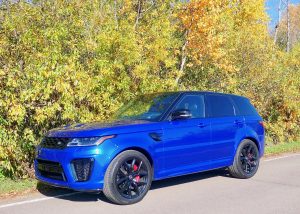
Range Rover Sport in Estoril Blue stood out against the autumn leaves, before the gales of October blew the colorful foliage away.
By John Gilbert
Dating back to when Land Rover’s Range Rover was a British brand of over-built SUVs from back before “SUV” became a working name, back when it was powered by a fun but less durable ‘Buick V6, it was hard to test-drive any Range Rover without being thoroughly impressed. The company’s staff of off-road adventurers could set up challenging off-road courses ir send you around Iceland or up to the Rocky Mountain continental divides to impress you with the vehicles’ prowess.
Over the last 20 years or so, I’ve been favorably impressed with all of them. Some more than others, of course. But now I’ve got a favorite — the Range Rover Sport SVR.
The Land Rover Discovery Sport, Land Rover Discovery, Land Rover Range Rover, Land Rover Range Rover Evoque, Land Rover Range Rover Velar, and the Land Rover Range Rover Sport all work together to make up the current exceptional stable of road-worthy — and off-road-worthy — SUVs. Different engines, different capabilities and different price ranges separate them from each other. The range goes from $39,000 for the compact Discovery Sport to a whopping $209,000 for the Land Rover Range Rover — which deserves both names, and then some.
The Range Rover Sport, however, stands tallest among the breed for those who love more sportiness than luxury while charging off the road to make their tracks where neighbors and others can be impressed but may not be able to keep up with your adventurousness. For those onlookiers, the Range Rover Sport stands out in plain sight, on the road.
You can buy a Range Rover Sport for $67,000 if you select the 2.0-liter turbo four with its hybrid boost, or a bit more for the 3.0-liter turbo-diesel. or you could step up to either of a pair of 3.0-liter supercharged V6es. But the pick of the litter is one of the two 5.0-liter V8 engines, with your choice of power. The first is a 518 horsepower, 461 foot-pound engine, which would be more than satisfying, if only the monster version didn’t exist.
That’s the one that came in my stunning Estoril Blue Range Rover Sport — the 5.0 supercharged V8 SVR, tuned by the corporate Special Vehicle Ops to 575 horses and 516 foot-pounds of torque. That, plus the load of unique equipment, take the $114,500 base price for the Range Rover Sport, and lift it to $131,520.
That’s a lot, but don’t dismiss it until you evaluate what you’re getting. Special Vehicle Ops is a performance oriented group that performs customizing on all things Jaguar or Range Rover. The two are jointly owned by Tata Motors in India, which admires the two British companies and has managed to extract the best from both. After sputtering, so to speak, on their own after being cut adrift by Ford Motor Company, the two were purchased by Tata, which gave Jaguar exactly what it needed — an enormous outlay of engineering money so they could build engines up to the standards promised by their beautiful sports cars and sedans. It only made sense to allow Range Rover to use the precious engines, instead of buying something from BMW, or Ford, or anyone else.
Special Vehicle Ops does a total custom job on the Range Rover Sport, installing perforated leather on the seats, special suspensions, aerodynamic tricks, until it rises above rivals to challenge the best from BMW X5, Mercedes AMG GLE after they get the M treatment, and even the Porsche Cayenne Turbo. An d then they install that magnificent engine, with its power raised from 518 to 575, and torque boosted from 461 to 516.
Range Rover always has impressed the hardiest of off-roading experts around the world, and if the nameplate came a bit late to the U.S., it started gaining popularity after broadening its scope as the vehicle of choice for the wealths Beverly Hills set. Many were sold to people who only drove them to their country club function, or to the studio, and never considered exercising that fabulous suspension.
People learned that Range Rovers could go anywhere, and their cult following grew. Fast, strong, go-anywhere, and do it in comfort and luxury. Electronic air suspension and all-terrain progressive control, and all the contemporary safety concepts are packing into the Range Rover Sport. So lane departure warning, emergency collision notification, plus roll stability control and dynamic stability control keep everybody safe and secure in their Range Rover cocoon.
As for sportiness, the Range Rover Sport looks the part, with that stunning blue color set off by black-spoked 22-inch alloy wheels, and the four rectangular exhaust tubes peeking out meaningfully at the rear. This is a 5,500-pound vehicle, but it takes off with all that thrust like a sports car. Its weight makes it lean a bit in cornering, because it is purposely tall both for ground clearance and for interior room. It leans, but it maintains its course and there’s never a thought that it might be too softly sprung. Even if you’re gazing from the passenger seats, up through the panbornic sunroof.
The engine is hooked up to an 8-speed automatic with steering wheel paddles if you want to impart manual control. The feel of the steering is a bit heavy for a luxury SUV, but that’s became Range Rover wants to make sure you know you can drive it off-road, which is to say through woods, up mountain sides, through gullies, and, if you so choose, to scale mountain tops and any manner of wilderness.
There are six selectable modes for driving, most of them covered by automatic, or the sportier dynamic. But you can specialize for rock climbing, running through sand or mud, or for snow.
Amazingly, there aren’t many directions Range Rover can go to restyle its vehicles, and that’s just fine. They all share the classy British corners and curves with each other, so you might be tempted to select a more inexpensive and more economical model and bank the rest, but with the Range Rover Sport, you already have promised a lot, whether from the little “SVR” badge on the tail, or the tight styling of the way the headlights are wrapped into the fascia.
You can take off like a rocket in the Range Rover Sport, and you probably will find the need to use that power and blast off. Besides, when it’s warm enough, you will want to open your windows so you can hear the meaningful exhaust note when you do hit it.
While the components under the Sport are overbuilt, the capabilities are enhanced. So you can tow 7,716 pounds of trailer, and weighing 5,500 pounds itself, you can still battle through weeds and woods until you find perpendicular facades for you to test the break-over ratio and other clearance concerns.
As for other creature comforts, you also have the Meridian Signature audio system that is as impressive as any sound system you can find. I guess 1,700 Watts can do that to you.
You can also find one of those 5.0-liter Special Vehicle Ops V8s with 575 horsepower in the largest Land Rover Range Rover, and Jaguar uses it in its F-Pace and F-Type SUVs. That’s right, while Jaguar still makes fantastic and exotic sports cars and luxury sedans, it has also been dabbling in SUVs and these two are gems.
And it’s only fair. If the state of the art in luxury SUVs is the Range Rover and it gets to use the Jaguar-designed engines to create the high-performing and sporty Range Rover Sport, it’s only fair for Jaguar to borrow some off-roading tricks from the masters of the art.


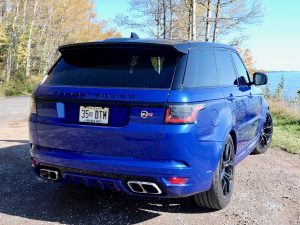
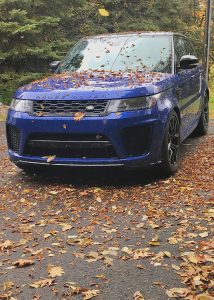
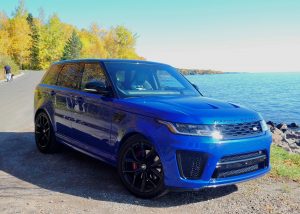
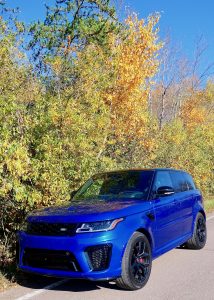
 John Gilbert is a lifetime Minnesotan and career journalist, specializing in cars and sports during and since spending 30 years at the Minneapolis Tribune, now the Star Tribune. More recently, he has continued translating the high-tech world of autos and sharing his passionate insights as a freelance writer/photographer/broadcaster. A member of the prestigious North American Car and Truck of the Year jury since 1993. John can be heard Monday-Friday from 9-11am on 610 KDAL(www.kdal610.com) on the "John Gilbert Show," and writes a column in the Duluth Reader.
John Gilbert is a lifetime Minnesotan and career journalist, specializing in cars and sports during and since spending 30 years at the Minneapolis Tribune, now the Star Tribune. More recently, he has continued translating the high-tech world of autos and sharing his passionate insights as a freelance writer/photographer/broadcaster. A member of the prestigious North American Car and Truck of the Year jury since 1993. John can be heard Monday-Friday from 9-11am on 610 KDAL(www.kdal610.com) on the "John Gilbert Show," and writes a column in the Duluth Reader.